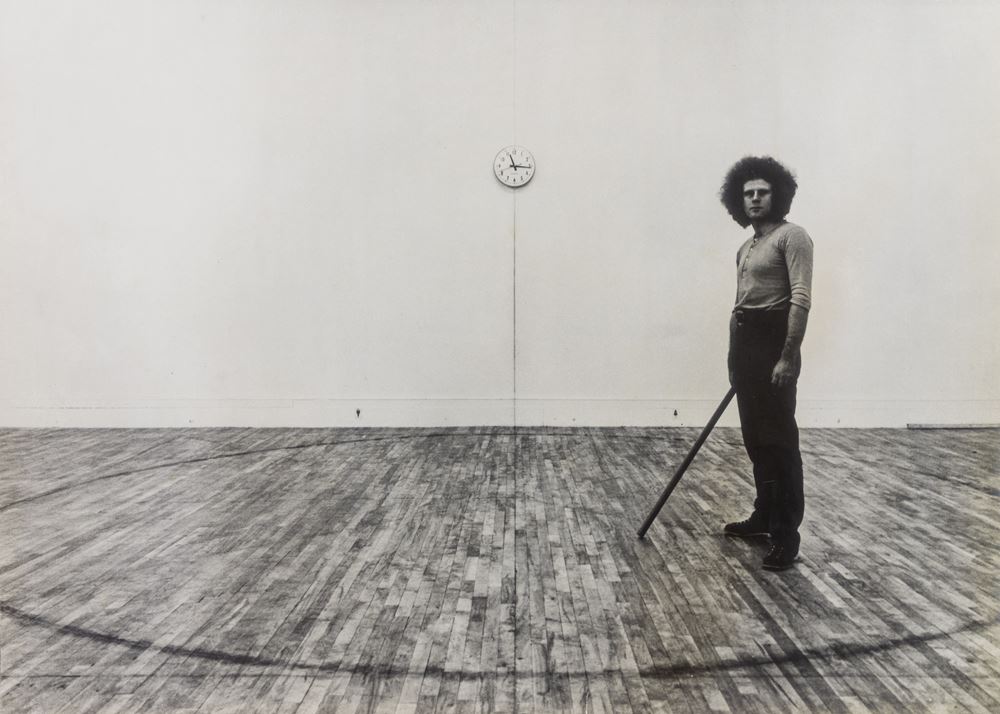


Thomas Brambilla Gallery is pleased to present Klaus Rinke first solo show at the gallery, which opens on Saturday April 24th, 2021 at 6:30 pm. The exhibition includes a series of iconic photographs from the Seventies, which best describes Rinke’s conceptualism.
In the mid-Sixties, Rinke developed his first performances titled "Primary Demonstrations". In such performances, he explored the concepts of masculine and feminine, as well as the spatiality and temporality of human existence. Rinke used his own body and gestures to construct "drawings in space" as a means to measure Space and Time. These works have contributed to developing a simple yet refined visual language that brings shapes, gestures, and elemental energies together as one. The exhibited works in the "Press the Bottom – Photographs from the Seventies" exhibition consist of photographs of the Artist demonstrating various aspects of bodily movement and properties in different internal and external spaces (nature, galleries, or museums). With these photographs, Rinke explained his own body, together with a "universal body", and their possibilities and proportions in Space and Time. Physiognomy, gestures, and actions are subject to a rigorous intellectual analysis. Time, frequently featured in Rinke's work and represented by a railway clock, is obviously a visual instrument measuring duration and impermanence. Besides, the clocks were meant to represent tools made by human beings, symbolizing the "universal time". Rinke's practice is centered on photography, where he perfectly manages to incorporate his fascination for Body, Space, and Time: "I made endless black and white photographs of the surfaces of the ocean, cut into them like a surgeon, one-sixtieth of a second of the surface's infinite movement".
The exhibition Press the Bottom – Photographs from the Seventies is also meant to illustrate the reexamination of conceptual photographic practice by Klaus Rinke in the Seventies.
Rather than record or aestheticize nature and the modern condition, as did many of the great photographers during the earlier part of the century, Rinke's photographs became evidence on which to document new conceptual, but also rational and scientific, approaches.
In the Seventies, in fact, IBM researchers Harlan Mills and Nicklaus Wirth created the so-called "top-down" and "bottom-up" approaches for the software development field. Specifically, "top-down" and "bottom-up" were both strategies of information processing and knowledge ordering, now used in various areas, including software, humanistic and scientific theories, management, and organization. While the "top-down" approach focuses on breaking down a big problem into smaller and more understandable pieces, the "bottom-up" approach first focuses on solving minor issues at the fundamental level and then integrating them into a whole and complete complex solution. Practically, they can be seen as a style of thinking, teaching, or even leadership. These innovative ways of thinking and acting made a massive impact on the Arts too.
Rinke, in fact, applied these experimental strategies to his photographic practice to better understand and solve the universal and primordial problems linked to Time, Space, and Body. He also applied the approaches to his own body, which served as an example of a universal body, to study and vivisect those three elements, just like a scientist would do. Indeed, Rinke made photographic material in such quantities that it resembled an obsession, but the real purpose was to find and create evidence and results. This allowed him to simplify the world's understanding for us and, then, to quickly make sense of all the information our senses can bring in. According to himself, Rinke looked for a code to decrypt Space, Time, and Body on which the world is based. The exhibited photographs in "Press the Bottom – Photographs from the Seventies" show us the results: parts of his body enlarged, facial gestures caught in multiple visualizations within seconds of each other, and his body located in various sequential positions in space. Just like in the "top-down" approach, Rinke dismantled the universal elements into small chunks to make them easily understandable. Subsequently, following the "bottom-up" way of thinking, he reconstructed the isolated pieces and proclaimed the global significance of the world's primordial structures.
|
This website uses third party cookies | X |
 This site uses anonymous technical cookies to ensure navigation and third-party cookies to monitor traffic and to offer additional services such as viewing videos or messaging systems. Without third-party cookies some pages may not work properly. Third-party cookies can track your activity and will only be installed by clicking on the "Accept all cookies" button. You can change your selection at any time by clicking on the "Cookie" link on each page at the bottom left. By clicking on one of the two buttons you declare that you have read the privacy policy and to accept the conditions.
This site uses anonymous technical cookies to ensure navigation and third-party cookies to monitor traffic and to offer additional services such as viewing videos or messaging systems. Without third-party cookies some pages may not work properly. Third-party cookies can track your activity and will only be installed by clicking on the "Accept all cookies" button. You can change your selection at any time by clicking on the "Cookie" link on each page at the bottom left. By clicking on one of the two buttons you declare that you have read the privacy policy and to accept the conditions.
| |
|